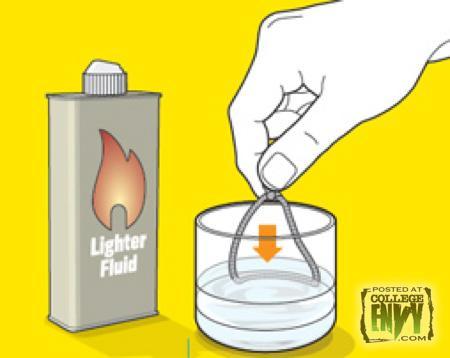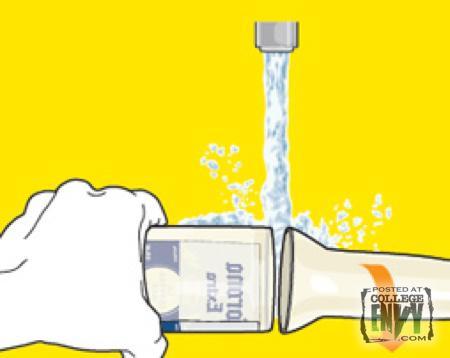Glassware Can Get Pretty Expensive Especially If You’re In College And Always Getting Sht Faced And







Glassware can get pretty expensive especially if you’re in college and always getting sht faced and breaking your glasses. Start just using your empty beer bottles and turning them into your new glasses. Look dope, easy to make and cheap! Follow these 5 easy steps.
Step 1 – Grab a beer bottle preferably with thick glass such as corona bottles. Tie a string just above the label on the empty bottle
Step 2 – Keep the string tied and soak it in lighter fluid.
Step 3 – Put the string back on the bottle and hold it horizontally. Light the sting rotating the bottle so the flame spreads. You should hear the bottle crack slightly in about 10 seconds.
Step 4 – After you hear the crack, pour cold water on the string and the top of the bottle will fall off.
Step 5 – Now grab sandpaper and sand the edges of the bottle till it is smooth.
More Posts from Solarpiracy and Others
incredibly funny to realise the US supports single-family zoning so much on the exact same material basis as the Wehrbauer system

A painting representing the surgical treatment of breast cancer - Richard Tennant Cooper








The Treasury of Atreus (or Tomb of Agamemnon) is an impressive tholos tomb located on the Panagitsa Hill at Mycenae, Greece. It was constructed around 1250 B.C. The tomb is constructed in the style of other tholoi of the Mycenaean world, nine in total around the citadel of Mycenae. With its monumental shape and grandeur, the Treasury of Atreus is one of the most impressive monuments surviving from Mycenaean Greece.
The lintel stone above the doorway weighs 120 tons and measures 8.3 x 5.2 x 1.2 meters, the largest in the world. The tomb was used for an unknown period. Mentioned by Pausanias, it was still visible in 1879 when the German archeologist Heinrich Schliemann discovered the shaft graves under the agora in the Acropolis at Mycenae. Although the tomb has no relationship with Atreus or Agamemnon, it was named thus by Heinrich Schliemann and the name has been used ever since.
It is formed of a semi-subterranean room of circular plan, with a corbel arch covering that is ogival in section. With an interior height of 13.5 meters and diameter of 14.5 meters, it was the tallest and widest dome in the world for over a thousand years. Great care was taken in positioning the enormous stones to guarantee the vault’s stability over time in bearing the force of compression from its own weight. This resulted in a perfectly smoothed internal surface, onto which could be placed gold, silver and bronze decoration.
The tholos was entered from an inclined uncovered hall or dromos, 36 meters long with dry-stone walls. A short passage led from the tholos to the actual burial chamber, which was dug out in a cubical shape.
The entrance portal to the tumulus was richly decorated: half-columns in green limestone with zig-zag motifs on the shaft, a frieze with rosettes above the architrave of the door, and spiral decoration in bands of red marble that closed the triangular aperture above an architrave. The capitals are influenced by ancient Egyptian examples. Other decorative elements were inlaid with red porphyry and green alabaster.
Mutual Aid Disaster Relief resource list masterpost
So I just found https://mutualaiddisasterrelief.org/resources/ And it is AMAZING.
I could share it as a link but many of you won’t click it and realize the abundance of things behind it that might be relevant to you right now. So Instead I’m gonna copy-paste the lot so you can all share in its glory. No part of this list was my work, I take no credit, I’m just the copy-paster.
The hotlines and specific services are US centric. If people wanna add less US-centric sources, please do.
Disaster Response
A Window Propped Open A Window Propped Open Issue 2: Lessons Learned Organizing After Hurricane Harvey A Love Letter to the Future Mutual Fire Brigade Basic Rescue Skills Trauma and Therapeutic Art: Information for Children, Families and Volunteers Transition is Inevitable; Justice is Not: A Critical Framework for Just Recovery Staying Above Water: Global Migration in the Face of the Climate Crisis Mutual Aid Disaster Relief: Navigating Trauma Citizen’s Guide for Readiness for Climate Extremes in the Desert Southwest Inhabit: Instructions for Autonomy Solidarity for Survival: A Graphic Illustration The Resilience We Want – A Guide to Making Your Community Space into a Hub for Resilience and Mutual Aid When We Got Handed Gatorade We Danced in the Street: A Survivor’s Survival Guide Prisoners in Disaster: The Legacy of Abuse, Exploitation and Endangerment of Prisoners in Disaster A People’s Framework for Disaster Response: Rewriting the Rules of Recovery after Climate Disasters
Disaster Disability Hotline
The Partnership For Inclusive Disaster Strategy’s Disaster Disability Hotline provides information, referrals, guidance, technical assistance and resources to people with disabilities, their families, allies, organizations assisting disaster impacted individuals with disabilities and others seeking assistance with immediate and urgent disaster-related needs.
The Disaster Hotline is always available for intake calls, 24 hours a day, 7 days a week, 365 days a year at (800) 626-4959 and info@disasterstrategies.org. They will have their knowledgeable team respond to your call as soon as possible, often immediately, and intend to respond to all callers within 24 hours.
Safety and DIY Cleanup
Repairing Your Flooded Home EPA Flood Cleanup Booklet DIY Field Guide For Clean-up Of Flooded Homes Safety Notice For Unskilled Or Nontrade Volunteers House Gutting Manual Muckout Safety Guidelines Toxic Chemicals and Staying Safe Mold Cleaning and Prevention Mold Cleaning and Prevention (Spanish) Black Mold Flyer
Wellness/Community Care
An Activists Guide to Basic First Aid Peer Counseling and Active Listening Alternatives to EMS Home Remedies for Common Maladies Traveling Companions Information on Heat and Related Illnesses Hypothermia Responding to Critical Incident Stress Class Struggle and Mental Health Zine Madness and Oppression Guide A Call for Prefigurative Mental Health Support and Communal Care for Radical Orgs
Emergency Prescription Assistance Program
The Emergency Prescription Assistance Program, or EPAP, was created to help people in a disaster who don’t have health insurance so they have access to: prescription medicine, medical equipment, medical supplies, and vaccinations. Hotline: 1-855-793-7470.
Trauma and Burnout
Mutual Aid Disaster Relief: Navigating Trauma Trauma_Overview Preventing Burnout Understanding and Coping with Traumatic Stress Understanding and Addressing Vicarious Trauma Grounding and Centering for Activists Rising Up Without Burning Out Sustainable Activism and Avoiding Burnout Psychological First Aid Activist Trauma and Recovery Trauma and Therapeutic Art: Information for Children, Families and Volunteers Community Trauma Toolkit Coping With_Climate_Change_Distress
Disaster Distress Helpline
The Disaster Distress Helpline, 1-800-985-5990, is a 24/7, 365-day-a–year, national hotline dedicated to providing immediate crisis counseling for people who are experiencing emotional distress related to any natural or human-caused disaster. This toll-free, multilingual, and confidential crisis support service is available to all residents in the United States and its territories. Stress, anxiety, and other depression-like symptoms are common reactions after a disaster.
Call 1-800-985-5990 or text TalkWithUs to 66746 to connect with a trained crisis counselor.
Legal/Security
Security Culture – A Handbook For Activists Ruckus Security Culture For Activists Know Your Rights: Immigration and Disaster Relief Council on American Islamic Relations Know Your Rights Guide National Lawyers Guild Know Your Rights Guide Why Misogynists Make Great Informants
Disaster Legal Hotlines
Legal Aid of North Carolina: 1 866 219 5262 Florida Legal Services’ Disaster Recovery: 888 780 0443 State Bar of Texas Disaster Hotline: 800 504 7030 California Disaster Legal Services For More Legal Aid Disaster Hotlines go to: American Bar Association
Anti Oppression
Accomplices Not Allies Why Misogynists Make Great Informants Who Is Oakland: Anti Oppression Activism, The Politics of Safety, and State Co-optation Anti-Oppression Reader With Allies Like These Challenging Capitalism And Patriarchy Confronting Classism Contextualizing Katrina and Confronting Racism Guidelines For Being A Strong White Ally Overcoming Discrimination Patterns of Patriarchy Commonly Observed within Social Justice Movements Readings on Racism and Resistance for Solidarity Activists Ten Things To Remember – AntiRacist Strategies For White Student Radicals The Revolution Starts At Home – Confronting Partner Abuse In Radical Communities Towards A Perspective On Unlearning Racism
Kitchen and Food Handling
Food Safety First Manual
Popular Education and Direct Action
You Have Skills: Evaluating What Skills You Can Bring to Radical Organizing From Banks and Tanks to Cooperation and Caring Handbook for Nonviolent Campaigns Handbook For Direct Action Affinity Groups Affinity Groups 2 On Strategic Nonviolent Conflict Participating In Direct Actions -A Guide For Transgender People Planning An Action Rising Tide Climate Change Popular Education Ruckus Action Planning Manual Ruckus Action Strategy Guide Ruckus Scouting Manual For Activists Social Change Vision Questions Core Curriculum – A Guide To Effective Nonviolent Struggle What Do We Mean by Mutual Aid? Metodo de Trabajo y Organizacion Popular Manual de Planificación Para Organizaciones Sociales
Water, Sanitation and Hygiene
No More Deaths – Compost Toilet User Guide Sanitizing Water (Spanish) – Saneamiento del agua (español)
Also for even more resources, check out this Mutual Aid Toolbox from Big Door Brigade and these How To guides from Shareable.
(I saw this and thought that it would help with the heat wave since a lot of people don’t have AC)
Heat Wave Peppermint Spray (AC in a Bottle)
10g peppermint essential oil 10g menthol essential oil Equal volume of solubilizer
200mL aloe vera juice
Weigh the essential oils out into an empty spray bottle, and top off with an equal amount of solubilizer. Swirl to combine. Add a small amount of aloe vera juice and shake gently to combine. Add the rest of the aloe vera, shake gently to combine.
To use, spritz on bare skin. If you cover your torso and your limbs, you will likely end up with goosebumps! I find this keeps me quite cool/cold for upwards of 20 minutes.
If you don’t want to use the solubilizer you can leave it out and just shake thoroughly before each use. That means the mixture will not emulsify at all and you’ll likely have troubles getting it to spritz evenly.
🐑 ❤️🧡💛💚💙💜 🐑
As Eid Al Adha is falling on the last few days of Pride Month this year, Eid Mubarak to all the lgbtq+ Muslims.
Remember that your queerness and diversity is a miracle from Allah SWT and that you were created perfect.
Whether you are celebrating alone, celebrating with family, celebrating with friends, or not celebrating at all, I hope this Eid Al Adha finds you all safe and at peace inshallah.
🐑 ❤️🧡💛💚💙💜 🐑

Vultures are holy creatures.
Tending the dead.
Bowing low.
Bared head.
Whispers to cold flesh,
“Your old name is not your king.
I rename you ‘Everything.’”

Despite their enormous ecological values, new research reveals we don’t understand how most arachnid species are faring right now – or do much to protect them.
Spiders need our help, and we may need to overcome our biases and fears to make that happen.“The feeling that people have towards spiders is not unique,” says Marco Isaia, an arachnologist and associate professor at the University of Turin in Italy. […] A new paper by Isaia and 18 other experts digs into the conservation status of Europe’s 4,154 known spider species and finds that only a few have any protection at the national level. Most have never even been adequately assessed or studied in detail, so we don’t know much about their extinction risk or their ecological needs.
Italy, for example, is home to more than 1,700 spider species, but fewer than 450 have had their conservation status assessed and only two have any legal protection in that country. Greece, meanwhile, has nearly 1,300 spider species within its borders, but scientists have only assessed the conservation needs of 32 of them. None are legally protected. […] “What surprised us most while assembling the data was the extremely poor level of knowledge about the conservation status, extinction risk and factors threatening the survival of European spider species, despite Europe being one of the most studied regions of the world in terms of biodiversity,” says Filippo Milano, the study’s lead author […].
And of course, this is not unique to Europe; other countries and continents fail to protect arachnids, and for similar reasons.
“Spiders are understudied, underappreciated and under attack by both the climate crisis and humans affecting our environment,” says spider expert and science communicator Sebastian Alejandro Echeverri, who was not affiliated with the study. “These are one of the most diverse groups of animals that we don’t really think about on a day-to-day basis. There’s like 48,000-plus species, but my experience is that most people don’t really have a sense of how many are in their area. In the United States, for example, we have just 12 spiders on the endangered species list out of the thousands of species recorded here.” This lack of information or protection at the national level affects international efforts. At the time the research was conducted the IUCN Red List, which includes conservation status assessments for 134,400 species around the world, covered just 301 spider species, eight of which are from Europe. That number has since increased — to all of 318 species from the order Araneae.
As we see with so many other wide-ranging species, a transnational border is often not a spider’s friend. The paper identifies several examples of species protected in one country but not its neighbor, despite being found in both places. According to the paper only 17 spider species are protected by conservation legislation in two or more European countries.
“Animals aren’t limited by our political lines on a map,” notes Echeverri. […]
And maybe, along the way, their work can help inspire people who fear spiders to look at them in a different light — or even to help look for them, like the Map the Spider project that asks citizen scientists to upload locations of the complex webs woven by elusive purse-web spiders. […]
“Focusing on spiders has been a very important choice […],” Isaia says. “You may study their web, their venom, their bizarre behaviors, the interactions between different species, their role as predators, their amazing taxonomical and functional diversity, their key role in the maintaining ecosystem equilibrium. You may also use them as sources of inspiration in architecture and visual arts. Aren’t these good reasons to find them attractive?”
——-
Headline and text published by: John R. Platt. “We Need to Talk About Spider Conservation.” As republished by Salon, 23 May 2021. Originally published by Platt at The Revelator, 10 May 2021.


Learn Stuff! // LINK
-
 persephoneysgarden reblogged this · 2 weeks ago
persephoneysgarden reblogged this · 2 weeks ago -
 bluefin60 liked this · 1 month ago
bluefin60 liked this · 1 month ago -
 eyes-paradise liked this · 2 months ago
eyes-paradise liked this · 2 months ago -
 annoyinglyvague liked this · 4 months ago
annoyinglyvague liked this · 4 months ago -
 dogbite747362 liked this · 4 months ago
dogbite747362 liked this · 4 months ago -
 mantenmeporquememuero7 liked this · 6 months ago
mantenmeporquememuero7 liked this · 6 months ago -
 lovingbeings-world liked this · 6 months ago
lovingbeings-world liked this · 6 months ago -
 annita893e7cjr47h liked this · 6 months ago
annita893e7cjr47h liked this · 6 months ago -
 annita89r4ten3h liked this · 7 months ago
annita89r4ten3h liked this · 7 months ago -
 hotstuffny liked this · 7 months ago
hotstuffny liked this · 7 months ago -
 twadi-gurl reblogged this · 9 months ago
twadi-gurl reblogged this · 9 months ago -
 sporadicnerdtrash liked this · 9 months ago
sporadicnerdtrash liked this · 9 months ago -
 wamangoli liked this · 10 months ago
wamangoli liked this · 10 months ago -
 artking-4 reblogged this · 10 months ago
artking-4 reblogged this · 10 months ago -
 neonspine liked this · 10 months ago
neonspine liked this · 10 months ago -
 chetungwan liked this · 10 months ago
chetungwan liked this · 10 months ago -
 copper-and-smoke reblogged this · 10 months ago
copper-and-smoke reblogged this · 10 months ago -
 copper-and-smoke liked this · 10 months ago
copper-and-smoke liked this · 10 months ago -
 bluemuraena liked this · 11 months ago
bluemuraena liked this · 11 months ago -
 lataupe69 liked this · 11 months ago
lataupe69 liked this · 11 months ago -
 dirtyknee liked this · 11 months ago
dirtyknee liked this · 11 months ago -
 fruitagusha liked this · 1 year ago
fruitagusha liked this · 1 year ago -
 smokey61 reblogged this · 1 year ago
smokey61 reblogged this · 1 year ago -
 thisisgettingdifficult reblogged this · 1 year ago
thisisgettingdifficult reblogged this · 1 year ago -
 somepoetryshit liked this · 1 year ago
somepoetryshit liked this · 1 year ago -
 elmecoseco liked this · 1 year ago
elmecoseco liked this · 1 year ago -
 happilykrispygalaxypensieri liked this · 1 year ago
happilykrispygalaxypensieri liked this · 1 year ago -
 dadirtymoney1 liked this · 1 year ago
dadirtymoney1 liked this · 1 year ago -
 blessedpanda liked this · 1 year ago
blessedpanda liked this · 1 year ago -
 thebrofriends liked this · 1 year ago
thebrofriends liked this · 1 year ago -
 book-ladder liked this · 1 year ago
book-ladder liked this · 1 year ago -
 edo1948 reblogged this · 1 year ago
edo1948 reblogged this · 1 year ago -
 edo1948 liked this · 1 year ago
edo1948 liked this · 1 year ago -
 scentedlovebeliever reblogged this · 1 year ago
scentedlovebeliever reblogged this · 1 year ago -
 scentedlovebeliever liked this · 1 year ago
scentedlovebeliever liked this · 1 year ago -
 themissourian liked this · 1 year ago
themissourian liked this · 1 year ago -
 legendarycashshoekid reblogged this · 1 year ago
legendarycashshoekid reblogged this · 1 year ago -
 legendarycashshoekid liked this · 1 year ago
legendarycashshoekid liked this · 1 year ago -
 ferrulepython reblogged this · 1 year ago
ferrulepython reblogged this · 1 year ago -
 travisruletheworld liked this · 1 year ago
travisruletheworld liked this · 1 year ago -
 interplanetaryheaux reblogged this · 1 year ago
interplanetaryheaux reblogged this · 1 year ago

a repository of information, tools, civil disobedience, gardening to feed your neighbors, as well as punk-aesthetics. the revolution is an unending task: joyous, broken, and sublime
211 posts